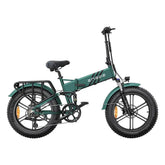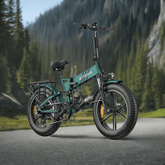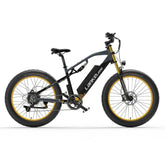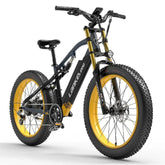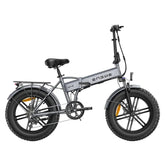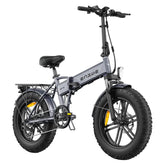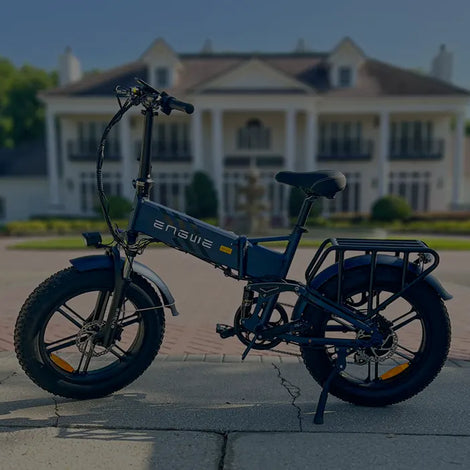The popularity of urban e riders is on the rise, as electric bicycles become a favored choice for eco-friendly transportation in cityscapes. They offer a swift and convenient way to navigate the urban sprawl, while also being kind to the environment. Despite their many benefits, it's crucial to consider safety measures just like with any other form of transit.
In this article, we'll provide you with comprehensive road safety guidance and tips that are imperative to follow for your security.
Must-Have Protective Gear for Electric Bicycle Riders
Riding an ebike is an efficient option for daily commutes, especially when covering shorter to moderate distances. Ensuring you're fully prepared before starting your journey on an e-bike is essential to ensure maximum safety. Therefore, the following accessories are necessary for optimal safety measures.
The protective gear known as a helmet is essential for safety.
Bicycle Helmet
Helmet use is critical in emergency situations, offering essential protection for your head. The repercussions of head injuries can be severe, making a helmet an indispensable piece of bicycle safety equipment to protect against serious harm or even death. Compliance with helmet laws is mandatory in many regions, and non-adherence can result in legal action or penalties.
As a responsible parent, demonstrating helmet use is vital not only for your protection but also to set a positive example for your children. Ensuring they wear appropriate protective gear is crucial for their safety while riding an e-bike. Additionally, helmets with reflective elements can significantly improve a rider's visibility, aiding in vision and hearing on the road.
High-visibility Vests/Apparel
For enhanced pedestrian safety and risk perception, choose reflective colors like orange, yellow, or green for your attire. These vibrant shades improve your ability to see and be seen by others, a crucial factor at night or in low-visibility conditions. Reflective clothing also helps other road users gauge the distance to you more accurately, reducing the likelihood of accidents.
Appropriate Footwear and Hand Protection
To ensure a safe and enjoyable e-bike ride, wearing the right shoes and gloves is paramount. Select gloves made from breathable materials that provide a strong grip and support, which are essential for maintaining control and balance on wet or slippery surfaces, contributing to overall e-bike safety.
Ensuring cycling safety, it is crucial to wear waterproof shoes and gloves to stay protected in harsh weather. Shoes with a flat sole provide better grip on the ground, enhancing stability while riding. In the unfortunate event of an accident, wearing the right shoes and gloves can shield your feet from bruises, cuts, or other injuries. For a secure and enjoyable ride, it is recommended to opt for closed-toe footwear with robust construction.
Additional Suggested Equipment and Add-ons
Beyond the accessories mentioned, integrating e-bike technology into your gear includes some essential safety items that are indispensable.
- Lights: For optimal traffic safety, it is important to equip your bike with both taillights and headlights, particularly for visibility when riding at night. It is highly recommended to invest in bright, durable lights that maintain power and can be easily recharged.
- Mirrors: Mirrors play a pivotal role in traffic management, enhancing the safety of riders by increasing their awareness of the surrounding environment. Handlebar mirrors, for instance, enable riders to monitor the area behind them without the need to turn, which is essential for safe navigation.
Get to know the traffic regulations and designated bike paths
The rules and regulations for e-bike riders vary across different cities and often depend on the type of electric bike and different age groups that are using them. Crafting these regulations ensures the safety and compliance of all riders.
Speed Limitations
Class 3 electric bicycles, showcasing advanced e-bike technology, boast higher power and can achieve the highest speed levels. Nonetheless, due to safety concerns, some states restrict their use.Class 1 electric bikes have a maximum speed of 20 mph, whereas class 3 can accelerate up to 28 mph.
Riding on the Right Side of the Road
In Europe, e-bike enthusiasts must prioritize traffic safety by riding on the right side, adhering to the same direction as motor vehicles to ensure smooth bike traffic flow. Electric bikes are typically governed by the same regulations as traditional bicycles in most states, yet it's wise to consult local authorities for any specific rules.
Utilizing Designated Bike Lane
Urban areas often feature designated lanes to streamline bike traffic, enhancing the safety and efficiency of the commute for both traditional and electric bike riders. To stay informed on the nuances of these lanes, it's advisable to verify any unique bike lane regulations within your state.
Hand Signals and Proper Turning
Mastering hand signals and turning techniques is a cornerstone of road safety for cyclists. It's essential to learn the correct method to signal your intentions to fellow road users, ensuring a safer riding experience for everyone.
Legal Requirements for Electric Bike Riders
Regulations for e-bike safety, integral to traffic safety, vary internationally and are influenced by factors like rider age, power output, and local traffic laws. These factors shape the e-bike safety standards across different countries. Most European nations typically cap electric bikes at a 250-watt power output and a maximum speed of 25 km/h, alongside mandating adherence to hand signals and bike lane usage.
Tips for Safe City Riding
Urban e-riders looking to navigate traffic congestion safely in cityscapes will find these tips invaluable for a secure and efficient journey.
Avoiding High-Traffic Roads
To mitigate the impact of traffic congestion and the associated noise pollution on health, it is recommended for e-bike riders to avoid major roads and highways. These areas can also present challenges in maneuvering e-bikes due to heavier traffic flows.
Staying Alert and Avoiding Sudden Movements
While riding, it is crucial to maintain a high level of risk perception; therefore, it is important to avoid distractions such as using headphones to ensure full awareness of your surroundings and a safer ride.
Being Visible and Avoiding Blind Spots
Enhancing pedestrian safety, especially during nighttime rides, involves the use of lights and donning reflective clothing. This proactive approach helps you stand out on dark paths and minimizes the risk of being in blind spots.
Managing Speed and Controlling Balance
To harness the full potential of e-bike technology, initiate your journey at a gentle pace and incrementally pick up speed. The innovative LCD display on your e-bike provides critical insights to optimize your ride. E-bike tips often highlight the importance of body positioning for maintaining control. Lean forward to distribute your weight when accelerating and shift backward when decelerating or braking to enhance your reaction ability.
Proper Maintenance of Your E-Bike
Regular maintenance is a cornerstone of e-bike safety. To ensure a secure experience, routinely inspect and service your electric bike's brakes, tires, chains, and other vital components to avert potential malfunctions.
Steps to Follow in Case of an Emergency
In the face of an emergency, maintaining composure is crucial for effectively managing risk factors. Furthermore, it is recommended to adhere to established safety precautions to safeguard yourself in such situations.
In the aftermath of traffic accidents, promptly evaluate injuries and alert law enforcement, especially if there's significant harm. It's essential to move to a secure location away from oncoming traffic to mitigate further risk and ensure safety.
Common injuries and first aid tips
E-bike accidents can lead to a spectrum of injuries, from minor abrasions to critical conditions like fractures or head trauma. Having a first aid kit accessible is vital, and for severe injuries, immediate medical attention is imperative.
Involving authorities and reporting incidents
In the event of traffic accidents resulting from someone else's negligence, it's imperative to involve the relevant authorities. Moreover, documenting the incident comprehensively is crucial, particularly if there was any property damage or loss as a consequence of the mishap.
Conclusion
Adopting the aforementioned measures is key to accident prevention and ensuring your safety. Also, taking necessary precautions, such as wearing a helmet and utilizing designated bike lanes, is vital for traffic safety and a secure commute. If all cyclists commit to these safety protocols, we can expect a notable reduction in urban accidents. This reduction will foster more efficient transportation for both citizens and state residents.

